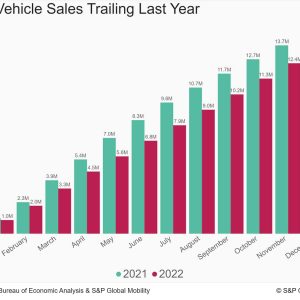
S&P Global Mobility: November auto sales continue previous three-month trend
This article was published by S&P Global Mobility and not by S&P Global Ratings, which is a separately handled division of S&P Global.
Continuous economic headwinds imply no news might be good news
concerning automobile need levelsWith volume for the month forecasted at 1.122 million systems,
November U.S. vehicle sales are approximated to translate to an approximated
sales rate of 14.1 million systems (seasonally adjusted yearly rate:
SAAR). This would represent a continual improvement from the May
through September duration but will reflect a decline from Octobers.
14.9 million-unit pace, according to S&P Global Mobility.
analysis.The daily selling rate metric in November (approximately 44-45K.
daily) would be in-line with levels since September. Translation:.
From a non-seasonally adjusted volume standpoint, auto sales.
continue to plug along at a stable speed.” Sales need to continue to improve, given the expected sustained,.
Moderate, development in total production and stock levels,”.
stated Chris Hopson, principal expert at S&P Global Mobility.
” However, we also continue to keep track of for signals of.
faster-than-expected growth in inventory. Presently, there are no.
clear indications; stocks have actually advanced as expected. Any.
indication of faster than projected development in the overall stock of.
brand-new automobiles might indicate that automobile customers are feeling the.
pressure of the existing economic headwinds and pulling back from the.
market.” As an outcome, Octobers SAAR boost is likely to be an abnormality.
compared to the rest of the year, Hopson said, including that.
there are expectations of volatility in the month-to-month results.
starting in early 2023. Market share of battery-electric cars is anticipated to reach.
5.9% in November. However, beyond the large coastal cities,.
retail registrations of EVs have yet to take hold, according to.
analysis from S&P Global Mobility.The top-eight EV markets in the US are all in seaside states and.
represent 50.5% of overall EV registrations so far in 2022 (through.
August). The higher Los Angeles and San Francisco cosmopolitan.
areas alone account for nearly one-third of overall share of the United States.
EV market. The Heartland states market share of EV sales.
is barely half of what they add to total automobile.
registrations.” BEV market share control on the two coasts is credited to.
their higher mix of early adopters compared to buyers in middle.
America,” stated Tom Libby, associate director of Loyalty Solutions.
and Industry Analysis at S&P Global Mobility. “Their.
market profile is more in sync with the standard BEV purchaser.
than the middle-American profile.” But Libby sees possible for EV approval in leading heartland.
markets: “More acceptance and much wider consumer awareness is.
leading to a natural progression of adoption from the coasts to.
the Heartland.” (For more on this analysis of EVs in the Heartland,.
please see.
this unique report.) Supporting the EV development, item exposes surrounding the.
Los Angeles Auto Show last week continue to show the OEM.
focus.According to Stephanie Brinley, associate director of.
AutoIntelligence at S&P Global Mobility, “As auto programs at.
their best emphasize what people will be driving in coming years,.
the reveals throughout the Los Angeles Auto Show show the continuing.
push toward electrical and amazed lorries.” Of note, Fiat announced it will bring a variation of the European.
500 EV to the U.S. beginning in early 2024, reviving the 500e.
nameplate. Toyotas expose of the 2023 Prius hybrid consisted of a.
Prime trim that will double the hatchbacks EV-only range, while.
the car manufacturer likewise revealed a making of the bZ (” Beyond Zero”).
electric-vehicle idea, previewing an upcoming compact SUV.
On the other hand, Vietnamese entrant VinFast showed U.S.-trim versions of.
two EV crossover additions to its lineup – bringing its potential.
United States offerings to four.
Leave a reply